This brilliant, prescient play helps explain the rise of Trump
By John Shand, Millie Muroi and Peter McCallum
SWEAT
Wharf 1 Theatre, November 15
Until December 22
Reviewed by JOHN SHAND
★★★★
It is no coincidence that Lynn Nottage’s Sweat arrived in 2015, the year Donald Trump erupted on to the US political landscape. Nottage’s story – the demise of Rust Belt manufacturing, with its consequent social and economic upheaval – is precisely what underpinned Trump’s MAGA movement.
The playwright spent two-and-a-half years interviewing residents of Reading, Pennsylvania, before putting pen to paper. While not a verbatim play, it is based on the realities of Reading losing its textile and steel industries, and the employees’ bewilderment and bitterness after generations of job security.
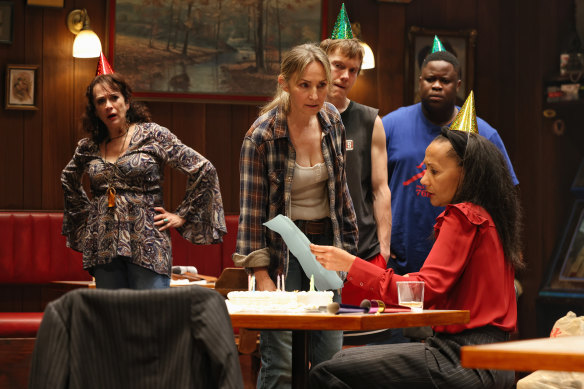
Deborah Galanos, Lisa McCune, James Fraser, Tinashe Mangwana and Paula Arundell in Sweat.Credit: Prudence Upton
Unable to survive, the community becomes a dog-eat-dog world of shattered friendships, families and racial cohesion. At the play’s epicentre is the irreparable rent in the long-term friendship between black Cynthia (Paula Arundell) and white Tracey (Lisa McCune). This comes when Cynthia is promoted from the steel mill’s shop floor into air-conditioned management – just before the owners pressure the workforce to take a plunge in pay and conditions, or be locked out and replaced, often by Latin American migrants.
Cynthia is a class traitor in Tracey’s eyes, but there’s also a racial dimension: a suspicion of the favouring of minorities in Cyn’s promotion. Cynthia, meanwhile, wonders if she was promoted precisely to be the fall guy for the lockout.
In Zindzi Okenyo’s STC production, the gifted Arundell makes Cyn so warm, bubbly and likeable as to retain our sympathy, even when there’s some truth to Tracey’s accusations. McCune so thoroughly reinvents herself as to be almost unrecognisable as the relentlessly spiky Tracey, whose cause has justice, but who goes too far in its pursuit. The third member of this one-time triumvirate is Jessie, engagingly played by Deborah Galanos, who’s natural vivacity cracks, and who slides into world-weariness and a default of drunkenness in what’s already a hard-drinking world.
Tinashe Mangwana and James Fraser play – and sometimes overplay – Chris and Jason, the short-fused sons of Cynthia and Tracey, respectively, and Markus Hamilton excels as both Cynthia’s downward-spiralling husband and a parole officer.
Most of the action takes place in a bar managed by Stan (a brilliant Yure Covich), who’s assisted by Oscar (Gabriel Alvarado). Oscar’s prepared to cross the steel-mill picket line to earn $11 an hour rather than his $8 in the bar, making him even more the enemy than the bosses.
Stan is the consistent voice of reason and sometimes a chorus-like commentator on the action. “I watch these politicians talking bullshit and I get no sense they even know what’s going on beyond the windshield of their cars as they speed past,” he tells Cynthia. And then when Chris and Jason are on the warpath he suggests they just leave town, instead. “Sometimes I think we forget we’re meant to pick up and go when the well runs dry,” he says. “You stay put for too long … your life becomes this pathetic accumulation of … emotional and physical junk.”
Needless to say, they don’t listen to him. In fact, no one’s listening to anyone by the end, although the climactic fight is not staged to maximum dramatic effect.
To see this the night after Tracy Letts’ August: Osage County is to marvel at the quality of 21st-century US playwriting. Both deal with the unravelling of the country’s social fabric. Letts’ is the more poetic and emotionally searing, but Nottage’s is exceptional in its own way, and Okenyo’s production, with set by Jeremy Allen and semi-industrial music by Brendon Boney, is the more even.
Aurora
Australian String Quartet
Utzon Room, Sydney Opera House
November 20
Reviewed by PETER McCALLUM
★★★★
The Australian String Quartet’s final program for the year had a Nordic focus with a dark work by contemporary Finnish composer Olli Mustonen and Grieg’s emotionally extravagant String Quartet.
Mustonen has been coming to Australia as a pianist for several decades and, although his compositions are less well known, the weighty expressiveness of his style is reminiscent of Shostakovich who is always popular among Sydney audiences.
Mustonen’s String Quartet No. 1 began with rasping dissonance in the violins alongside thundering tumult from the cello like an avalanche of rocks collapsing into a chasm. There were arresting strident strokes and impulsive urgency before a quieter viola cadenza which, either by design or coincidence, played with the intervals of the musical monogram that Shostakovich made of his own name.
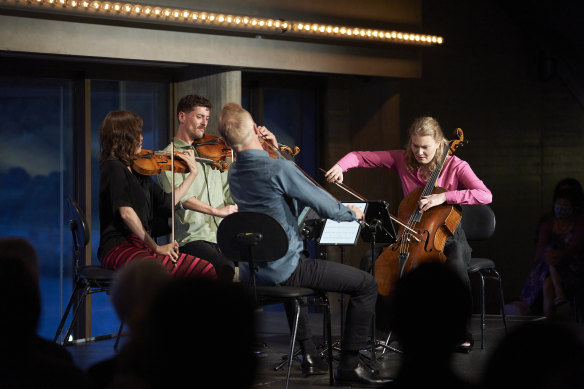
The Australian String Quartet’s future is looking good as they enter their 40th year.Credit: Jay Patel
The sense of angst remained until the cello subsided to slow but ominous repeated chords, while the violins played figurations of glassy wispiness over the top, like ice crystals in half-light. The turning point came in the third movement with the appearance of a chorale, where dissonance was expunged in favour of harmonious chords set in a floating tonality as though no longer bound by gravity.
The opening returned and led to a short finale full of irregular hyperactivity and vigour – perhaps too short given the weight of the previous music. The ASQ played with cohesive tone and forceful expression. In the concert’s opening work, Haydn’s String Quartet in D, opus 76, no. 5, the phrasing was elegant, though, from my vantage point, the balance was less cohesive.
In the second half, the ASQ began Grieg’s String Quartet No. 1 in G minor with sonorous strength and gave a distinctive cold edge to sudden dissonant chord in the ninth bar. As this full-toned intensity subsided, leader Dale Barltop introduced a tone of sinewy expressiveness as the music transitioned to the second theme. The changeable second movement lurched with playful abandon between coy dialogue and scurrying agitation.
The swagger of the third movement gave way to jauntiness as guest cellist Charlotte Miles led off the central section like one of those dances learned in primary school where each pupil is expected to do a turn in the centre of the circle. The ASQ maintained the expansive sound in the finale which boiled with incendiary energy.
Bartrop’s leadership of the ASQ over 8 years has been a stabilising strength and bodes well as they enter their 40th year in 2025.
Die Walkure
Sydney Symphony Orchestra
Opera House Concert Hall, November 15
Reviewed by PETER McCALLUM
★★★★★
Staged productions of opera, as philosopher Theodor Adorno observed, tend to become parodies of themselves. With its warrior maidens and thunderous Valkyries Ride, this is a particular danger with Die Walkure, the first true part of Wagner’s great trilogy Das Ring des Nibelungen (following Aeschylus and anticipating Douglas Adams, Wagner insisted the four evenings formed a trilogy, regarding Das Rheingold, which the SSO presented last year, as an introduction).
Held aloft by voices of magnificent splendour and musicality, and riding nothing more substantial than great waves of orchestral sound, this concert performance by the Sydney Symphony Orchestra under chief conductor Simone Young eschewed tinned trappings to drive straight to the work’s essence, which sets human love and worldly power in irreconcilable opposition.
When Tommi Hakala as Wotan sang of “the End” with terrifying starkness in Act II, one didn’t need an avant-garde director to interpret its contemporary relevance. But don’t worry. With the SSO presenting only one opera annually, the end of the world is still two years away.
After Young led a bristling prelude of welling clamour, Stuart Skelton as Siegmund and Vida Mikneviciute as Sieglinde created a first act of nuanced intimacy, cultivating delicate shades in a musical half-light that budded rapturously into surging sunny brilliance after a beautifully transparent cello solo by Kaori Yamagami. Against this delicately coloured warmth, Peter Rose sang Hunding with implacable heft and hewn strength but without a hint of splintery roughness, wonderfully supported by the gnarly robustness of a quartet of Wagner tubas.
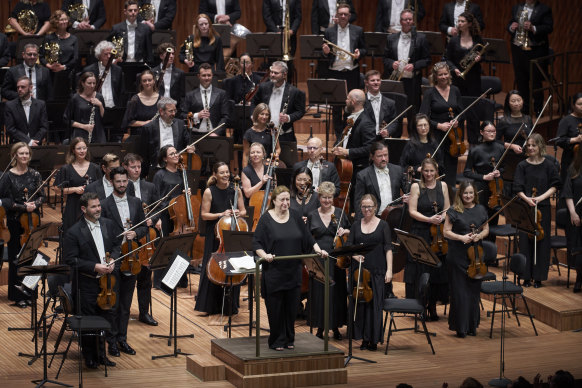
The Sydney Symphony Orchestra under the direction of Simone Young.Credit: Jay Patel
The second act revealed the vocal range of Hakala’s Wotan, starting with lusty confidence against Anja Kampe’s wild yelps and vertiginous slides as Brunhilde. But his voice darkened ominously as he unsuccessfully mansplains his ideas to Alexandra Ionis’s Fricka, whose formidably firm contralto voice was leavened with an even velvety finish of burgundy richness. In his subsequent monologue with Brunhilde, Hakala moved in masterly gradations from bleakly whispered nothing to fiercely raging despair.
Mikneviciute delivered Sieglinde’s hallucinatory nightmare with passionate derangement while never losing the aqua-tinted colour and noble clarity of her voice. In the scene in which Siegmund and Brunhilde confront mortality, Skelton shaped each question with a quietly glowing halo of golden hue, rising to a superbly finished peak of resolute declamation.
At the close of the act, Kampe transformed her premonitory portentousness to vividly towering strength. After a thrilling display of vocal swagger from the eight Valkyries at the start of Act III, Mikneviciute returned briefly for the evening’s most spellbinding moment as she is told she is to bear the future Siegfried. When she sings, there are moments when one forgets everything else.
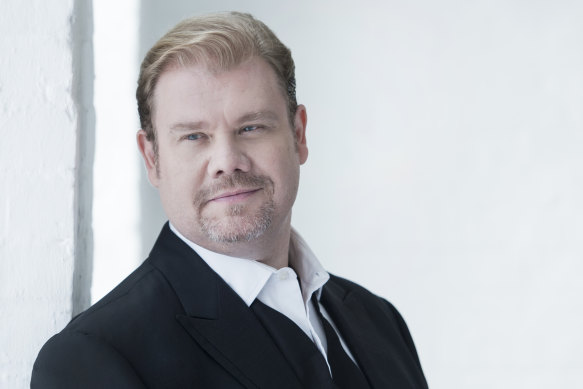
Tenor Stuart Skelton sings Siegmund in the SSO’s triumphant performance.Credit:
Kampe’s Brunhilde phrased her acceptance and interrogation of Wotan’s wrath with deeply persuasive musicality and dominated the full orchestra with awe-awakening power. Wotan’s farewell retained Hakala’s fine-edged clarity and grained strength even as it surged with warmth.
Young balanced the psychological complexity of Brunhilde and Wotan’s final scene with subtly interwoven threads of woodwind colour from oboe, cor anglais and clarinet (Shefali Pryor, Alexandre Oguey, Francesco Celata).
The serene transparency of quietly animated strings, harps, translucent wind and warm brass for the closing fire scene created an orchestral sound of glistening transparency rarely experienced with such clarity when confined to an opera pit. Fresh from Young’s triumph this year as the first Australian to conduct The Ring at the Bayreuth Festival, which Wagner founded in 1876, this more than met the expectations of last year’s Rheingold, and without a horned helmet in sight.
AUGUST: OSAGE COUNTY
Belvoir St Theatre, November 14,
Until December 15
Reviewed by JOHN SHAND
★★★★
The August heat in Oklahoma’s Osage County kills pet tropical birds. It doesn’t do much for people, either. They claw at each other like pterodactyls, because a soft heart equals vulnerability when what’s needed to survive in Osage County – in the Weston family, at least – is strength and venom.
That’s how Violet, the matriarch, has survived, despite being a pill-popper for decades, despite having mouth cancer and despite her husband, Beverly, having long given up his career as an acclaimed poet to become what she terms “a world-class alcoholic”.
Tracy Letts’ 2007 play is a truly great work, with Violet one of the juiciest roles of all time. Initially, it seemed Pamela Rabe may not rise to Violet’s challenge, but then the whole first act of Eamon Flack’s production was flat, partially because everyone other than John Howard (Beverly) and Helen Thomson (Violet’s sister, Mattie Fae) was too soft. Sensational lines were being wasted.
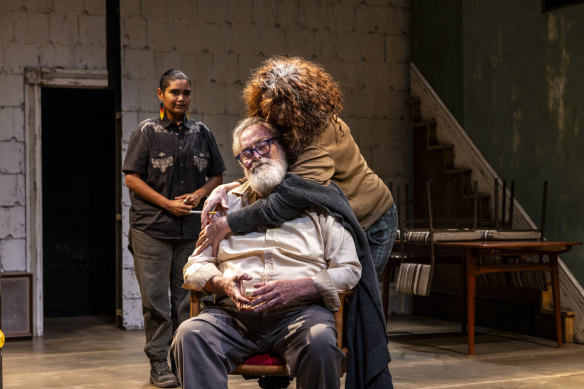
Bee Cruse, John Howard and Pamela Rabe.Credit: Brett Boardman
In act two, the production suddenly reared up on its hind legs and became frightening in its power, ferocity, heart and humour. By now, Beverly has drowned himself: possibly to end his inconsolable disappointment at having written nothing for 50 years, possibly out of guilt over an old affair, possibly due to an insufferable life in a lonely house – their three daughters having flown the coop – with Violet’s tongue to lash him towards more whiskey. Suddenly, Rabe is Violet in every cell of her being as, addressing her dead husband, she spits, “You think I’ll weep for you?” Of course she can’t: that would be a crack in the steel.
As everyone assembles for the post-funeral lunch, Rabe’s Violet assumes a power and savage wit that would have made Zeus flinch on his throne, let alone this ragtag assemblage of family. When she sees the gentlemen have stripped down to their shirts, she hisses, “I thought we were having a funeral dinner, not a cockfight,” whereupon they dutifully don their jackets in the appalling heat.
She then demands someone say grace, which falls to her hapless brother-in-law, Charlie (Greg Stone), whose ineptitude makes this among theatre’s most amusingly excruciating speeches. But even as the hilarity builds throughout the scene, so does the malignity, and seated at the table is the one person who’s almost a match for Violet: her oldest daughter, Barbara (Tamsin Carroll).
Carroll, too, rises in act two. Hers is a harder character to like than Rabe’s, being lacerated with bitterness because her husband, Bill (Bert LaBonte), has left her for a younger woman. (In Violet’s savagely pragmatic world, that’s just the way things are.) The chemistry between Violet and Barbara is critical to the play’s success, and Rabe and Carroll make this ferment, even as we wince at their ferocity and what their ferocity hides.
Flack’s production, designed by Bob Cousins, dismantles Letts’ three-storey rural house, instead offering a vision of a home disintegrating as rapidly as its family, as if the vast mid-western plains are reclaiming what was once theirs. Besides Rabe and Carroll, the cast of 12 includes compelling performances from Thomson, Stone, Howard, Anna Samson (the live-wire Karen Weston) and Johnny Nasser (the sheriff). Dialect flaws with the “o” vowels, alas, afflict the whole cast.
The extraordinary play even anticipates future events. “This country,” says Barbara, “this experiment, America, this hubris: what a lament, if no one saw it go. Here today, gone tomorrow. Dissipation is actually much worse than cataclysm.” That we shall see.
The Kid Laroi
CommBank Stadium
November 15
Reviewed by MILLIE MUROI
★★★
The Kid Laroi is the kind of act you want to love. The Sydney-born hip-hop talent has been through more than his share of hardships at just 21 years old and speaks to life’s pressures in a candid, soulful way.
But capturing a crowd involves more than just nailing the vocals and bringing boundless energy to the stage. Returning to his home city on tour for his debut studio album The First Time (2023), Laroi’s best moments were when he delved a little deeper and connected with his audience.
He seemed comfortable skulking around the stage, and showed off his raspy yet impressively versatile voice – especially in songs such as Deserve You from his latest album – but there was little variation in his movements, and little change in pace until dance number Girls lifted the energy well into the show.
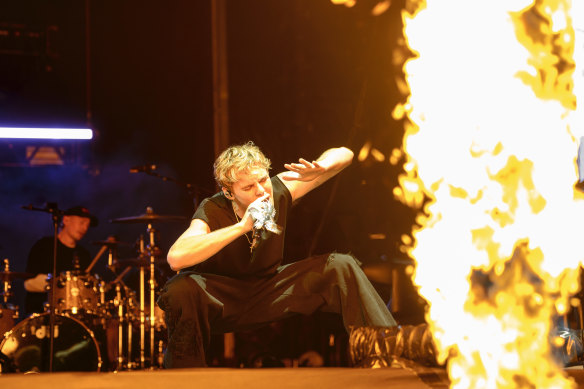
The Kid Laroi has come a long way from difficult beginnings.Credit: Ashley Mar
Laroi was also often shrouded, particularly from a production perspective. Repeated, pre-recorded imagery on the screens with little relevance to many of the songs made Laroi’s live performance fade into the smoke and stage, especially from a distance.
He bounced back well from several interruptions including a serious crowd injury during single So Done from his first mixtape in 2020. But his tendency to face his band, or turn away frequently, even when addressing the crowd, perhaps betrayed a lack of confidence, although that gradually improved throughout the show.
Having worked with industry icons including Justin Bieber for his 2021 hit single Stay, it’s perhaps little surprise that Laroi shines when he performs alongside other artists. The singer-songwriter took fans back to the first song he put on streaming platforms, aged just 14, bouncing off the energy of rapper Nooky who joined him on stage for a rendition of Blessings.
Laroi has come a long way from difficult beginnings. By better connecting with his crowd – through sharing the stories behind some of his songs, changing up his movements or simply facing his fans more often – Laroi could make his presence match his lyrical finesse and bring home a stronger performance.
THEATRE
THE END OF THE WHARF AS WE KNOW IT!!!
Seymour Centre, November 12
Until December 23
Reviewed by JOHN SHAND
★★★★
Wanted: satirists to fill gaping holes in the political and theatrical landscapes. Must be able to write, act, sing, dance, direct, play musical instruments, cross-dress, mimic, and be funny for 25 years. Yes, that’s how long Jonathan Biggins, Drew Forsythe and Phillip Scott have been creating and performing The Wharf Revue, having announced The End of the Wharf as We Know It!!! is their final splash.
Helping them maximise the displaced water were the inestimable Mandy Bishop, whose acting range has enriched so many editions, and the versatile David Whitney, diving in for a third time.
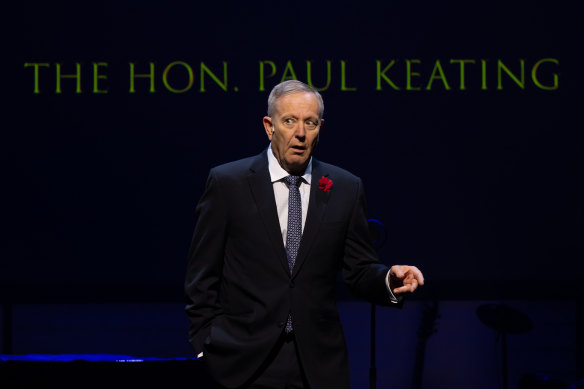
Jonathan Biggins reprises his timeless Paul Keating.Credit: Vishal Pandey
Despite the challenging physics, they managed to go out on a high while making that final splash, the pinnacle being Bishop reprising her Jacqui Lambie, this time MC-ing the parliamentary Midwinter Ball and singing a revamped River Deep – Mountain High. There’s always been a divide between the pollies lampooned affectionately and those who, having been skewered, receive an extra twist of the blade. Lambie is in the former bag, and Bishop’s mimicry and Tina Turneresque dancing even outstripped the sidesplitting lines.
As well as a disturbingly creepy Rupert Murdoch, Drew Forsythe administered a final dose of Pauline Hanson, a feat of mimicry that’s become more eerily accurate with the passing years. The queen of spoonerisms assured us that British Muslims believe Shakespeare wrote his plays in Islamic pentameter, that she is not anti-semantic, and nor is she self-defecating.
Biggins reprised his timeless Paul Keating, gave us a grotesquely idiotic Tony Abbott, a young Albo and the self-destructive Adam Bandt (singing “I’m Bandt” to Michael Jackson’s I’m Bad). Scott revisited his Kevin Rudd, who’s grown ever weirder, and offered cameos as diverse as Miriam Margolyes, Alan Kohler and a gifted musical director. Or perhaps the latter was real. Whitney had fun with Joe Hockey to Biggins’ Mathias Cormann, while his pitch-perfect Peter Dutton was part Evangelical, part Halloween spook.
They astutely shied away from Trump (what more can be said?), and a Zuckerberg/Musk/Bezos sketch landed rather bumpily on Mars. But lesser material fades quickly from the mind, leaving ample room to relish countless uproarious moments from across all those years. What a gift – not just to us but to the health of the political discourse. The run-up to Christmas will never be the same again.